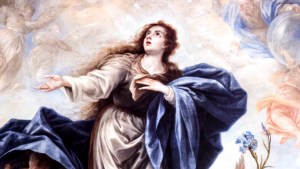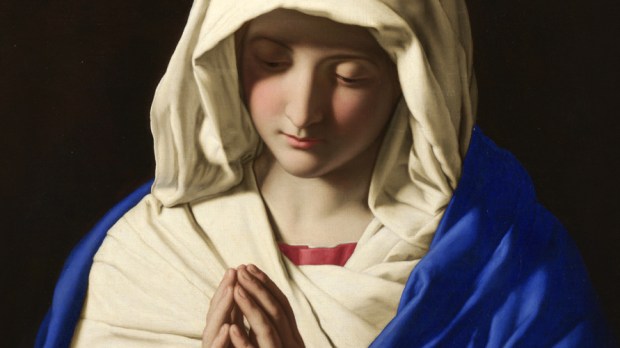Many of our Protestant friends and even some Catholics don’t understand it. They think the Church makes up stuff, and the claim that Mary was conceived without original sin is often their Exhibit 1. They say it’s unbiblical and unnecessary. The feast gives us a chance to explain what the Church does, and what she doesn’t do. It shows us the Church’s modesty, not something we often think about in relation to her teaching.
All the pope can do is pass along what the Church knows and not a word more. He speaks as the Supreme Pontiff and the Vicar of Christ, the Pontifex Maximus, but even as those things, he speaks as a steward, not as an inventor. That’s all Pope Pius IX was doing on December 8, 1854, when he proclaimed the doctrine of the Immaculate Conception.

Read more:
What I learned as a convert about the Immaculate Conception
The Church’s modesty
We don’t often think about the Church’s modesty in what she tells us. We see her rich and complex teaching. Just look at how fat is the Catechism of the Catholic Church, and that’s just a summary. Go to the Vatican website and see how much the modern popes have written.
The Church seems to say something about almost everything. God has not left his people without instruction. We ask lots of questions and God through the Church gives us lots of answers. As a Protestant drawn to the Church, I found that scary. She said so much. Surely she was making up a lot of it.
But the Church tries not to go beyond what God has told us through Holy Scripture and Sacred Tradition. She doesn’t embroider and elaborate, as nearly any purely human institution would. Anyone who’s served on a committee writing a public statement knows how they grow and grow.
She doesn’t embroider and elaborate, as nearly any purely human institution would.
The Church speaks modestly, of what she knows. We see this in the process by which Pius IX came to declare the Immaculate Conception and in the declaration itself.
Many of our Protestant friends will argue that the Church went wrong about Mary really early, and that the pope found what he wanted to find. They insist the Church invents things left and right. We can answer them, partly by noting that the Church operates under the precedent of the first council of Nicaea. There, almost 300 years after the Lord’s Ascension, the Church found the word homousios to describe who Jesus is. As our Protestant friends would agree, she invented nothing then. She only articulated something the Church had already seen.
But here I only want to point to how carefully the Church speaks. If she happily invented things, we’d see a great deal more than we do.
The Pope describes
In the Apostolic Constitution Ineffabilis Deus, the pope declares that “the most Blessed Virgin Mary, in the first instance of her conception, by a singular grace and privilege granted by Almighty God, in view of the merits of Jesus Christ, the Savior of the human race, was preserved free from all stain of original sin, is a doctrine revealed by God and therefore to be believed firmly and constantly by all the faithful.”
That’s it for the doctrine. In the rest of the Constitution, which runs about 6,500 words in the English translation, he gives reasons for believing it. But he doesn’t argue for it very much, in the sense of asserting certain truths and building an argument from them. He testifies to what the Church has received that leads him to declare that the faithful must believe in Mary’s immaculate conception.
He mostly describes how the Church has always believed it. He describes what the Fathers taught about the Mother of God, and the popes, the Counter-Reformation’s Council of Trent, and the whole Catholic world. He describes what we know from the Church’s worship and devotion. He makes a couple of references to Scripture, but even here he only shows that the doctrine fits what we know from Scripture. He explains at some length how the whole Catholic world studied the question, adding their voices to the voices of the past.
It’s only then that he declares the definition, which takes up just 63 of those 6,500 words. Before he declares it, he explains his reason for doing so. He speaks as a man under authority.
“Wherefore, in humility and fasting, we unceasingly offered our private prayers as well as the public prayers of the Church to God the Father through his Son, that he would deign to direct and strengthen our mind by the power of the Holy Spirit,” he says. “In like manner did we implore the help of the entire heavenly host as we ardently invoked the Paraclete.” The declaration follows a few words later.
That’s the process, which speaks to the Church’s modesty. So does the declaration. It says … not much. The definition by itself is only 45 words long. It says only that God, through Jesus’s work, preserved his mother from original sin. Again, no embroidery and elaboration. Just the truth that the Church has to share. In and out with admirable efficiency and simplicity.
The Church speaks what she hears
The Catholic Church says a lot, but not because she makes it up. She says a lot because she insists God has told us a lot. She speaks of only of what she’s heard.
I would say one more thing. The Church speaks modestly because her doctrines work like seeds. Each has within it a great and beautiful tree. The Church needs only to plant the seed and her people will grow it into the tree whose fruit we can eat and in whose shade we can rest. In declaring the truth of the Immaculate Conception, the Church gives us yet another reason to love the Blessed Mother, and you see in every church the tree of devotion Catholics have created.
~
For more on this, see an article I wrote some years ago in what I called “first week of Mary 101 form.” It’s called Delivered from All Stain https://www.firstthings.com/web-exclusives/2010/12/delivered-from-all-stain . I also cover this in more detail in my book Discovering Mary https://www.amazon.com/Discovering-Mary-Answers-Questions-Mother/dp/0867169273 .

